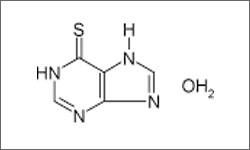Mercaptopurine (6-mercaptopurine or 6-MP)

The purine antagonist 6-Mercaptopurine has been used as a chemotherapy drug for over 30 years. The drug is usually given orally. When higher doses are required, the drug may be given through an IV. Patients suffering from acute lymphocytic or myelocytic leukemia, lymphoblastic leukemia (especially in childhood cases) and acute myelogenous and myelomonocytic leukemias are often given 6-MP (Purinethol®, Puri-Nethol®) in combination with other chemotherapy drugs. In addition to its role in cancer treatment, 6-MP is used to treat patients suffering from a variety of inflammatory bowel diseases. The drug is also used to prevent rejection following organ transplants. 1
- 1 Chu, E., & DeVita, V. T. (2015). Physicians' cancer chemotherapy drug manual 2015. Burlington, MA: Jones & Bartlett Learning.
6-MP is very similar to the purine bases in DNA. When used in DNA replication (copying), it prevents cell division. This also leads to inhibition of DNA synthesis and function, as 6-MP incorporates thiopurine nucleotides. 6-mercaptopurine (6-MP) causes remissions in childhood leukemia cases without severely harming normal cells.1
The diagram below shows the 3D molecular structure of 6-Mercaptopurine.
- 1 Chu, E., & DeVita, V. T. (2015). Physicians' cancer chemotherapy drug manual 2015. Burlington, MA: Jones & Bartlett Learning.
Side effects include low blood counts (Myelosuppression), mouth sores, diarrhea, skin rash/acne, mild nausea, abnormal liver function. Side effects are rare in children.1
- 1 Chu, E., & DeVita, V. T. (2015). Physicians' cancer chemotherapy drug manual 2015. Burlington, MA: Jones & Bartlett Learning.
